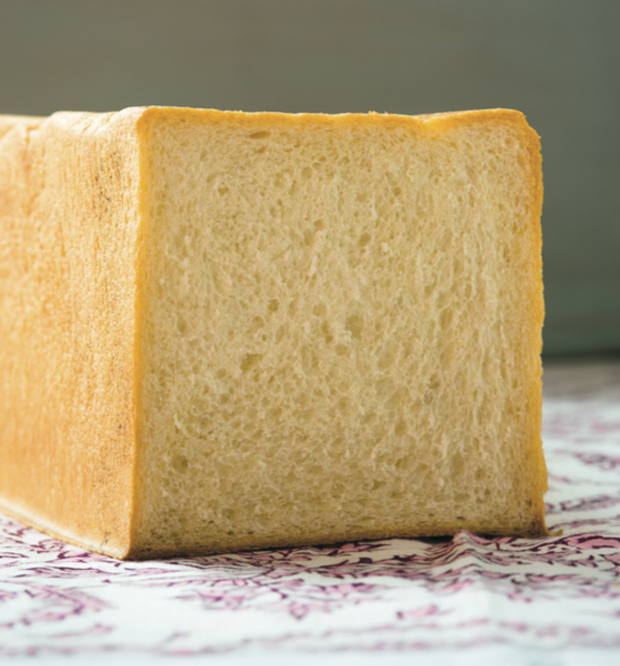Recipe
January 12, 2016
Pain Au Lait

White bread has gotten itself a bad name – shorthand for insipid, industrial bread. This classic loaf has lots of soul and flavor and will put white bread back in your good graces. While this dough can be formed into many shapes, we often sell it as a pullman loaf, a traditional sandwich bread. The one pictured here is made in the bakery for food service, but your home version will have a domed top. The milk in the dough adds softness and extends the bread’s shelf life; the butter keeps it moist.
Directions
Yield: Makes 2 9-inch Loaves
- Mix together the yeast and milk in the bowl of a stand mixer fitted with a dough hook. Add the flour, sugar, salt, and melted butter and mix on low speed until the ingredients are combined, 1 to 2 minutes. Increase the speed to medium-high and mix until the dough is smooth, pulls away from the sides of the bowl (and leaves the sides clean), has a bit of shine, and makes a slapping noise against the sides of the bowl, about 6 minutes. Do the windowpane test (*see below for instructions) to check to see if the gluten is fully developed.
- Put the dough in a large clean bowl and cover with plastic wrap (or put the whole bowl in a large plastic bag). Let stand at room temperature until tripled in size, about 1 1⁄2 hours.
- Coat 2 (9 × 5-inch) loaf pans with oil.
- Turn the dough out onto a lightly floured work surface. Divide into 2 equal pieces (each weighing about 23 ounces). Working with one piece at a time (keep the other covered with plastic), form a pullman (to do this, first form a log roll, then give the dough a few extra rolls on the floured surface so that it forms a loaf to fit your pan, usually 8 to 10 inches/20 to 25 cm. Put the roll into the pan, seam side down.) Roll the dough on the floured surface so that it forms a loaf that measures 9 inches. Repeat the process with the second piece of dough. Put the loaves, seam side down, into the prepared loaf pans. Cover loosely with plastic wrap and let stand until they fill the pans by about three-quarters, about 1 hour.
- Meanwhile, preheat the oven to 400°F.
- Brush the loaves lightly with water or lightly mist them with a spray bottle. Bake until the breads are golden brown and sound hollow when tapped, 30 to 40 minutes. Let the loaves cool in the pans for 5 minutes. Then loosen the loaves and turn them out on their sides onto wire racks. Let them cool completely on their sides. Store in a paper or cloth bag for up to 1 day. After that, store in a plastic bag at room temperature.
*Windowpane test: Tear off a small piece of dough about the size of a golf ball. If it is sticky, dredge it through a little extra flour to make it easy to handle. Use your hands to gently stretch the dough from all sides until it forms a thin, nearly transparent layer that you can see the light through if you hold it up to an actual window or light. If you can stretch the dough to that state, it means the gluten is developed and your bread is ready to rise. Simply press the small dough ball back into the large one and proceed. If, on the other hand, your dough tears before you can stretch it thin enough to see the light through it, keep kneading it until it passes the test. The windowpane test does not work with doughs that have whole grains, nuts, or seeds in them, nor is it necessary with ryes.
Excerpted from The Hot Bread Kitchen Cookbook. Copyright © Jessamyn Waldman Rodriguez, 2015. Principal photographs by Jennifer May © 2015. Additional photographs by Evan Sung © 2015.
Excerpted by permission of Clarkson Potter/Publishers, an imprint of the Crown Publishing Group, a division of Penguin Random House LLC, New York. All rights reserved.


